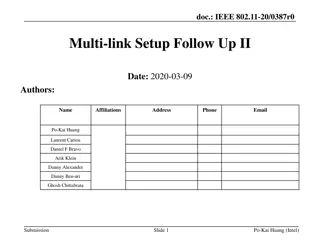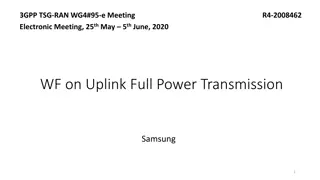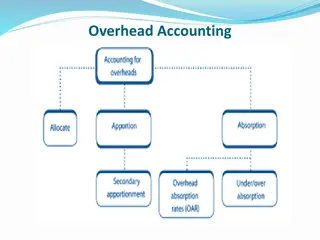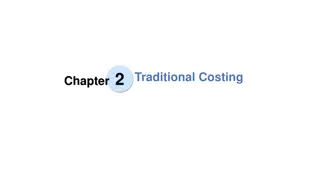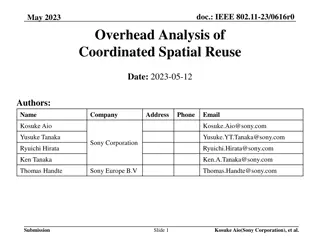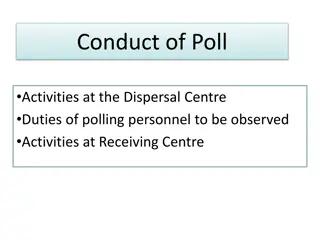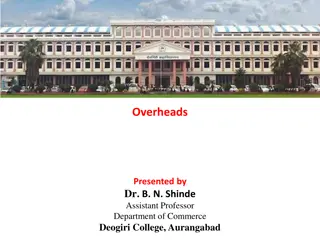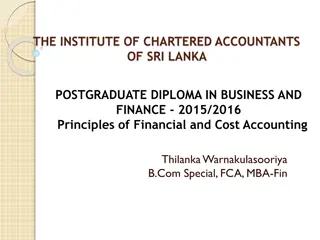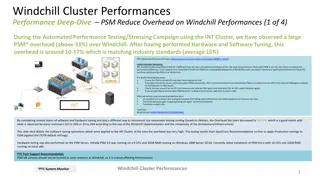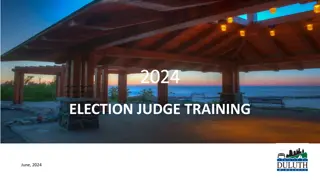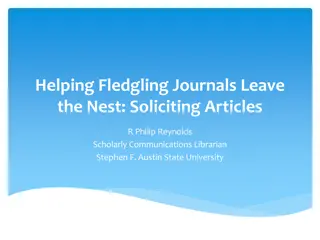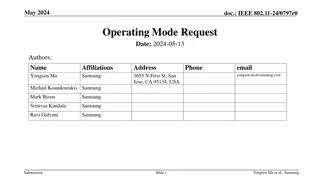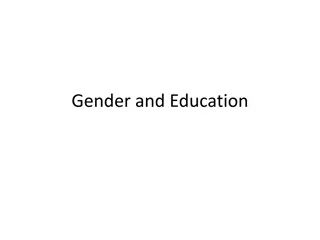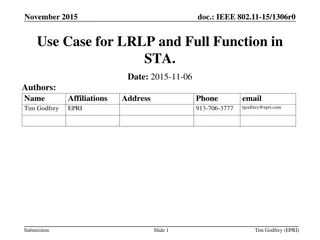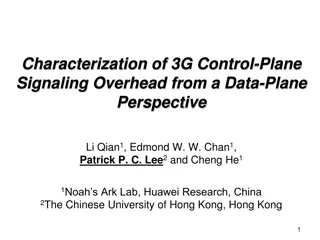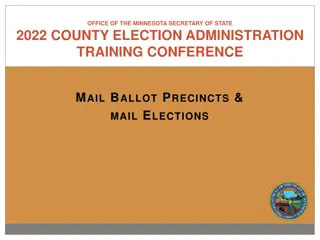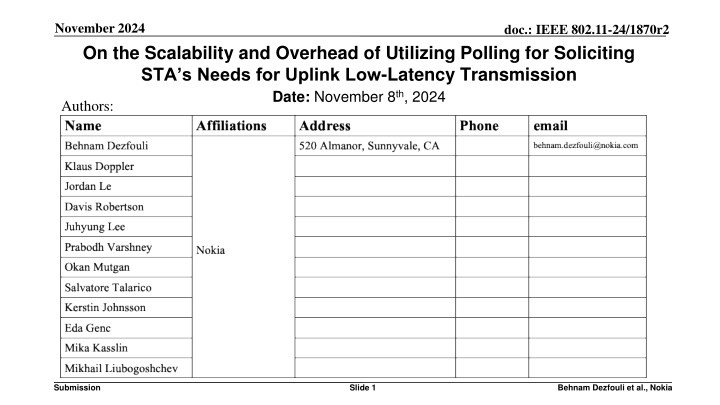
Scalability and Overhead of Polling for Uplink Low-Latency Transmission
Explore the scalability and overhead of using polling mechanisms to solicit station needs for efficient uplink low-latency transmission in IEEE 802.11 networks. Understand the impact of varying factors such as the number of stations, available bandwidth, and modulation and coding schemes on polling overhead. Discover sample applications and methods for utilizing polling during transmission opportunities.
Download Presentation

Please find below an Image/Link to download the presentation.
The content on the website is provided AS IS for your information and personal use only. It may not be sold, licensed, or shared on other websites without obtaining consent from the author. If you encounter any issues during the download, it is possible that the publisher has removed the file from their server.
You are allowed to download the files provided on this website for personal or commercial use, subject to the condition that they are used lawfully. All files are the property of their respective owners.
The content on the website is provided AS IS for your information and personal use only. It may not be sold, licensed, or shared on other websites without obtaining consent from the author.
E N D
Presentation Transcript
November 2024 doc.: IEEE 802.11-24/1870r2 On the Scalability and Overhead of Utilizing Polling for Soliciting STA s Needs for Uplink Low-Latency Transmission Date: November 8th, 2024 Authors: Submission Slide 1 Behnam Dezfouli et al., Nokia
November 2024 doc.: IEEE 802.11-24/1870r2 Introduction UHR aims to provide more predictable delays and reduce tail latency For aperiodic low-latency (LL) traffic, the AP must have up-to-date information regarding the current needs of STAs to effectively allocate communication resources The AP can utilize polling mechanisms to actively request Buffer Status Reports (BSRs) from STAs In this contribution, we study the overhead of polling STAs based on BSRP and BSR frames We show the impact of the number of STAs, available bandwidth and MCS on polling overhead Submission Slide 2 Behnam Dezfouli et al., Nokia
November 2024 doc.: IEEE 802.11-24/1870r2 Introduction A sample application of using polling is during TXOPs If the TXOP holder is the AP, it can use a portion of its acquired TXOP to poll non-AP STAs about their needs to send UL LL traffic If the TXOP holder is a non-AP STA, it may share a portion of its TXOP with the AP to send DL LL traffic or poll non-AP STAs about their needs for sending UL LL traffic Sample methods have been proposed in [11-24/0390r0] [11-24/0870r0] [11-24/629r0] [11-23/1886r3] [11-24/0168r0] [11-23/1874r0] Submission Slide 3 Behnam Dezfouli et al., Nokia
November 2024 doc.: IEEE 802.11-24/1870r2 An Example Method of LL Traffic Exchange during TXOPs TXOP Duration Transmission Period Transmission Period LL Traffic Exchange Non-AP STAX is the TXOP holder and communicates with the AP Non-AP STAX is the TXOP holder and communicates with the AP TXOP shared with the AP to perform LL traffic exchange In the above figure: Transmission Period refers to the durations where the TXOP holder oversees the TXOP and communicates with the responder(s) (e.g., a non-AP STA transmits frames to the AP) LL Traffic Exchange refers to a period during which the AP can use the TXOP to perform LL traffic exchange with non-AP STAs Polling Process To assess the need for UL traffic exchange, the AP can poll STAs The AP sends BSRP, and in response, the STAs respond with BSR frames Submission Slide 4 Behnam Dezfouli et al., Nokia
November 2024 doc.: IEEE 802.11-24/1870r2 The AP polls three STAs, two of which report LL traffic The AP schedules UL traffic from these two STAs Polling Duration AP sends a TF to schedule UL traffic from STA 3 and STA 4 AP polls STAs BSRP TF AP STA 1 LL Traffic Exchange Transmission Period TXOP Holder BSR STA 2 BSR DATA STA 3 These two STAs have LL data to send BSR DATA STA 4 The main purpose of this contribution is to study the overhead (duration) of the polling process Submission Slide 5 Behnam Dezfouli et al., Nokia
November 2024 doc.: IEEE 802.11-24/1870r2 Polling Duration The overhead of polling depends on the following parameters The duration of BSRP frames The duration of BSR frames The number of polling rounds required to poll the STAs The duration of each BSRP Trigger Frame (TF) depends on The number of STAs that are being polled by the BSRP frame (5 bytes/STA) MCS and bandwidth available The duration of each BSR frame depends on MCS and bandwidth allocated to the STAs sending BSR If we assume a 242-tone RU is assigned to each STA, a bandwidth of ? 20 MHz is used for receiving BSR frames from ? STAs concurrently If we assume a 106-tone RU is assigned to each STA, a bandwidth of ? 10 MHz is used for receiving BSR frames from ? STAs concurrently Submission Slide 6 Behnam Dezfouli et al., Nokia
November 2024 doc.: IEEE 802.11-24/1870r2 In the following example, the TXOP holder is not the AP During the LL Traffic Exchange duration, the TXOP holder allows the AP to perform STA polling Assume up to four STAs can be polled concurrently by each BSRP frame One polling round is enough to poll the four STAs The BSRP frame allocates resources to STAs 2, 3, 4, and 5 to reply back One polling round Polling Duration TF BSRP AP LL Traffic Exchange STA 1 Transmission Period TXOP Holder BSR STA 2 STA 3 STA 4 STA 5 DATA BSR DATA BSR DATA BSR Submission Slide 7 Behnam Dezfouli et al., Nokia
November 2024 doc.: IEEE 802.11-24/1870r2 Six STAs are polled by the AP, where four STAs can be polled concurrently by each BSRP frame Two polling rounds are required to poll the six STAs Note: since the second BSRP allocates resources to a lesser number of STAs than the first one, the size of the second one is smaller This BSRP frame allocates resources to STAs 6 and 7 to reply back Second polling round This BSRP frame allocates resources to STAs 2, 3, 4, and 5 to reply back First polling round TF BSRP BSRP AP LL Traffic Exchange STA 1 TXOP Holder Transmission Period Transmission Period BSR STA 2 DATA BSR STA 3 DATA BSR STA 4 DATA BSR STA 5 BSR DATA STA 6 BSR DATA STA 7 Polling Duration Submission Slide 8 Behnam Dezfouli et al., Nokia
November 2024 doc.: IEEE 802.11-24/1870r2 Evaluation: How long it takes to poll a certain number of STAs? When presenting results, we show two horizontal lines Red line: 300 ??(10% of a 3 ?? TXOP) Blue line: 800 ??(10% of an 8 ?? TXOP) If the available bandwidth is 40 MHz, STAs cannot be polled within a reasonable time frame If the available bandwidth is 160 MHz, polling 20 STAs takes about 200 us and up to 35 STAs can be polled in under 300 s Using smaller RUs, more STAs can be polled concurrently and the overhead BSRP frames drops Submission Slide 9 Behnam Dezfouli et al., Nokia
November 2024 doc.: IEEE 802.11-24/1870r2 Summary For aperiodic and LL traffic, the AP needs to have up-to-date information about the demands of STAs The AP may rely on polling to solicit BSRs The number of STAs that can be polled concurrently depends on the available bandwidth and RU sizes supported by STAs When smaller RUs are assigned to STAs for reporting their BSR, a greater number of STAs can be polled concurrently; although the duration of BSR frames increases, the reduction in the number of BSRP frames is more impactful and results in shorter polling periods Overall, the overhead of polling may be unacceptable, especially when the available bandwidth for polling is less than 80 MHz Therefore, to identify STAs that need to transmit UL LL traffic, depending on the number of STAs and available bandwidth, more efficient polling and/or random-access methods may be required Submission Slide 10 Behnam Dezfouli et al., Nokia
November 2024 doc.: IEEE 802.11-24/1870r2 Straw Poll Do you agree that 11bn should introduce new mechanisms to enhance the efficiency of polling STAs or identifying LL STAs? Yes/No/Abstain Submission Slide 11 Behnam Dezfouli et al., Nokia
November 2024 doc.: IEEE 802.11-24/1870r2 Appendix A BSRP and BSR Frames Submission Slide 12 Behnam Dezfouli et al., Nokia
November 2024 doc.: IEEE 802.11-24/1870r2 Overhead of Buffer Status Report Poll (BSRP) Frame Buffer Status Report Poll (BSRP): This Trigger Frame (TF) allows the AP to poll STAs The minimum size of the Common Info field is 8 bytes The User Info List size depends on the number of users being polled: 5 bytes per user Submission Slide 13 Behnam Dezfouli et al., Nokia
November 2024 doc.: IEEE 802.11-24/1870r2 Overhead of Buffer Status Report Poll (BSRP) Frame Total BSRP Frame = PHY Header + MAC Header + Common Info + User Info List + FCS = PHY header + 16 bytes + 8 bytes + 5 bytes x (#users) + 4 bytes (??+?+? ?+?) ? ? The duration of BSRP frame when polling ? STAs: PHY duration + Assuming R = 8.6 Mbps, the total airtime for polling one STA is PHY Header Duration + MPDU = 40 s + 30.69 s 70.69 s Additional assumption A single PHY stream The PHY header includes legacy fields Submission Slide 14 Behnam Dezfouli et al., Nokia
November 2024 doc.: IEEE 802.11-24/1870r2 Overhead of Buffer Status Report (BSR) Frame Buffer Status Report (BSR): Included in QoS Data frames, QoS Null frames, and/or Management frames For BSR frames, we assume MAC header carries two addresses BSR is included in the A-Control subfield (A-Control is included in the HT-Control field) QoS Control field is not needed Total NDP/BSR Frame Size = PHY Header + MAC Header + HT Control Field + FCS = PHY header + 18 bytes + 4 bytes + 4 bytes = PHY header + 26 bytes Assuming a data rate of R = 8.6 Mbps (802.11ax, MCS 0, BPSK , 20 MHz, 0.8 us GI) Total airtime of one BSR frame: PHY Header Duration + MPDU= 40 s + 24.18 s 64.18 s Additional assumption A single PHY stream The PHY header includes legacy fields Submission Slide 15 Behnam Dezfouli et al., Nokia
November 2024 doc.: IEEE 802.11-24/1870r2 Appendix B Additional Results Submission Slide 16 Behnam Dezfouli et al., Nokia
November 2024 doc.: IEEE 802.11-24/1870r2 Evaluation Case We change the number of tones assigned to STAs reporting BSR RU allocation algorithm: For a given available bandwidth, if assigning the minimum-size RU to each STA results in unused bandwidth, the RU assignment algorithm will attempt to allocate the next possible size of RU to each STA, while striving to minimize the number of polling rounds required PHY: OFDMA (802.11ax), 0.8us GI, one SS The PHY header of all frames include legacy fields When presenting results, we show two horizontal lines Red line: 300 ??(10% of a 3 ?? TXOP) Blue line: 800 ??(10% of an 8 ?? TXOP) Submission Slide 17 Behnam Dezfouli et al., Nokia
November 2024 doc.: IEEE 802.11-24/1870r2 Submission Slide 18 Behnam Dezfouli et al., Nokia
November 2024 doc.: IEEE 802.11-24/1870r2 Submission Slide 19 Behnam Dezfouli et al., Nokia
November 2024 doc.: IEEE 802.11-24/1870r2 Submission Slide 20 Behnam Dezfouli et al., Nokia



